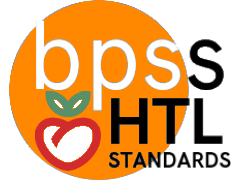BPS District Health Standards Book
Standards
Growth and Development
- HTL-K2.s1.01: Identify how health behaviors affect mental, emotional, physical and social health.
- HTL-K2.s1.02: Recognize that there are multiple dimensions of health.
- HTL-K2.s1.03: Describe ways to prevent contagious diseases.
- HTL-K2.s1.04: Identify ways to prevent common childhood injuries.
- HTL-K2.s1.05: Describe why it is important to seek health care.
- HTL-K2.s1.06: Explain how responsibility changes as we grow older
- HTL-EL.s1.01: Describe the relationship between health behaviors and social, emotional, physical, and mental health.
- HTL-EL.s1.02: Identify examples of social, emotional, physical, and mental health.
- HTL-EL.s1.03: Describe ways in which a safe and healthy school and community environment can promote personal health.
- HTL-EL.s1.04: Describe ways to prevent common childhood injuries and health problems.
- HTL-EL.s1.05: Describe when it is important to seek health care.
- HTL-EL.s1.06: Explain the stages of social, emotional, physical and mental growth and development in humans from infancy to late adulthood.
- HTL-EL.s1.07: Define abstinence in relation to health behaviors.
- HTL-06.s1.01: Analyze the relationship between health behaviors and personal health.
- HTL-06.s1.02: Identify examples of mental, emotional, physical, and social health.
- HTL-06.s1.03: Describe how the environment can promote personal health.
- HTL-06.s1.04: Describe how family history can affect personal health.
- HTL-06.s1.05: Identify adolescent health problems.
- HTL-06.s1.06: Explain how appropriate health care can promote personal health.
- HTL-06.s1.07: Describe the benefits of and barriers to practicing health enhancing behaviors.
- HTL-06.s1.08: Examine the likelihood of injury or illness if engaging in unhealthy behaviors.
- HTL-06.s1.09: Explain mental, emotional, physical and social changes that occur during adolescence.
- HTL-06.s1.10: Define abstinence in relation to health behaviors.
- HTL-MS.s1.01: Analyze the relationship between health behaviors and personal health.
- HTL-MS.s1.02: Describe the interrelationships of emotional, mental, emotional, physical, and social health in adolescence.
- HTL-MS.s1.03: Analyze how the environment affects personal health.
- HTL-MS.s1.04: Describe how family history can affect personal health.
- HTL-MS.s1.05: Describe ways to reduce or prevent injuries and other adolescent health problems.
- HTL-MS.s1.06: Explain how appropriate health care can promote personal health.
- HTL-MS.s1.07: Describe the benefits of and barriers to practicing health enhancing behaviors.
- HTL-MS.s1.08: Examine the potential seriousness of injury and illness if engaging in unhealthy behaviors.
- HTL-MS.s1.09: Identify the anatomical structures of the reproductive system.
- HTL-MS.s1.10: Explain the processes of conception, prenatal development, and birth.
- HTL-MS.s1.11: Identify the benefits of abstinence and/or contraceptive methods.
- HTL-MS.s1.12: Acknowledge differences among individuals regarding gender.
- HTL-HS.s1.01: Predict and/or evaluate how health behaviors can affect health status.
- HTL-HS.s1.02: Analyze the interrelationships of mental, emotional, physical, and social health.
- HTL-HS.s1.03: Analyze how environment and personal health are interrelated.
- HTL-HS.s1.04: Analyze how genetics and family history can impact personal health.
- HTL-HS.s1.05: Formulate strategies to reduce or prevent injuries and health problems.
- HTL-HS.s1.06: Analyze the relationship between access to health care and health status.
- HTL-HS.s1.07: Analyze the benefits of and barriers to practicing a variety of health enhancing behaviors.
- HTL-HS.s1.08: Examine personal susceptibility to and severity of injury, illness, or death if engaging in unhealthy behaviors.
- HTL-HS.s1.09: Explain the functions of the reproductive system.
- HTL-HS.s1.10: Describe prenatal and postnatal practices that can contribute to or threaten a healthy pregnancy for parent and child.
- HTL-HS.s1.11: Compare and contrast the advantages and disadvantages of abstinence and other contraceptive methods, including condoms.
- HTL-HS.s1.12: Acknowledge differences among individuals regarding gender.
- HTL-HS.s1.13: Analyze characteristics of healthy and unhealthy relationships with family, peers, and other adults.
